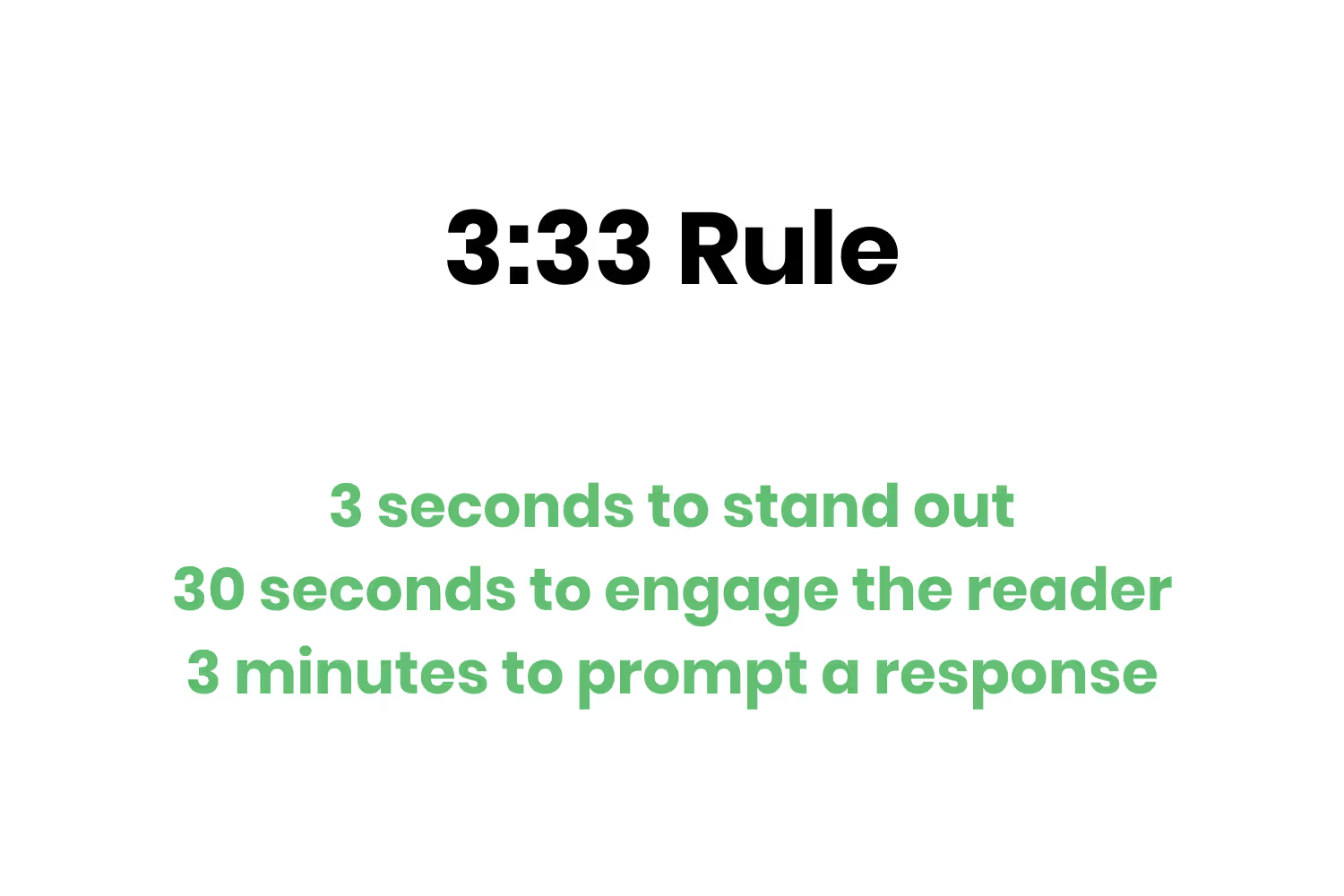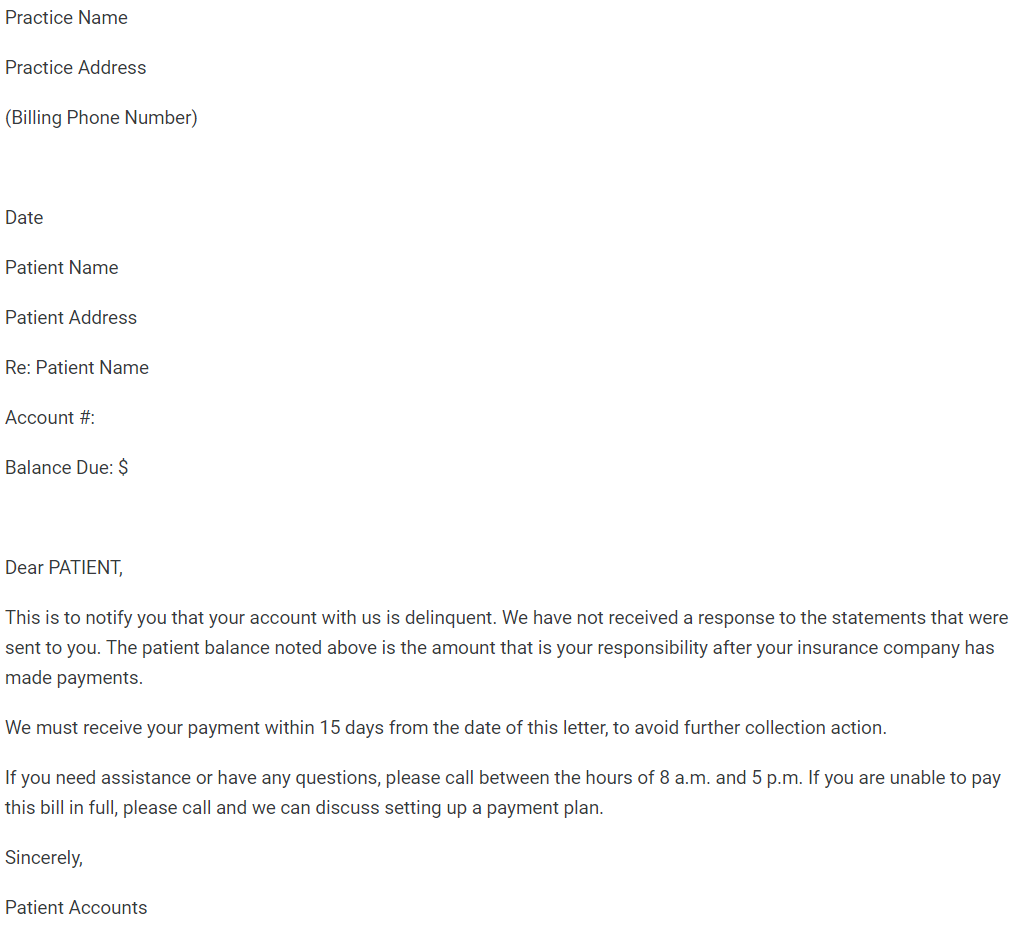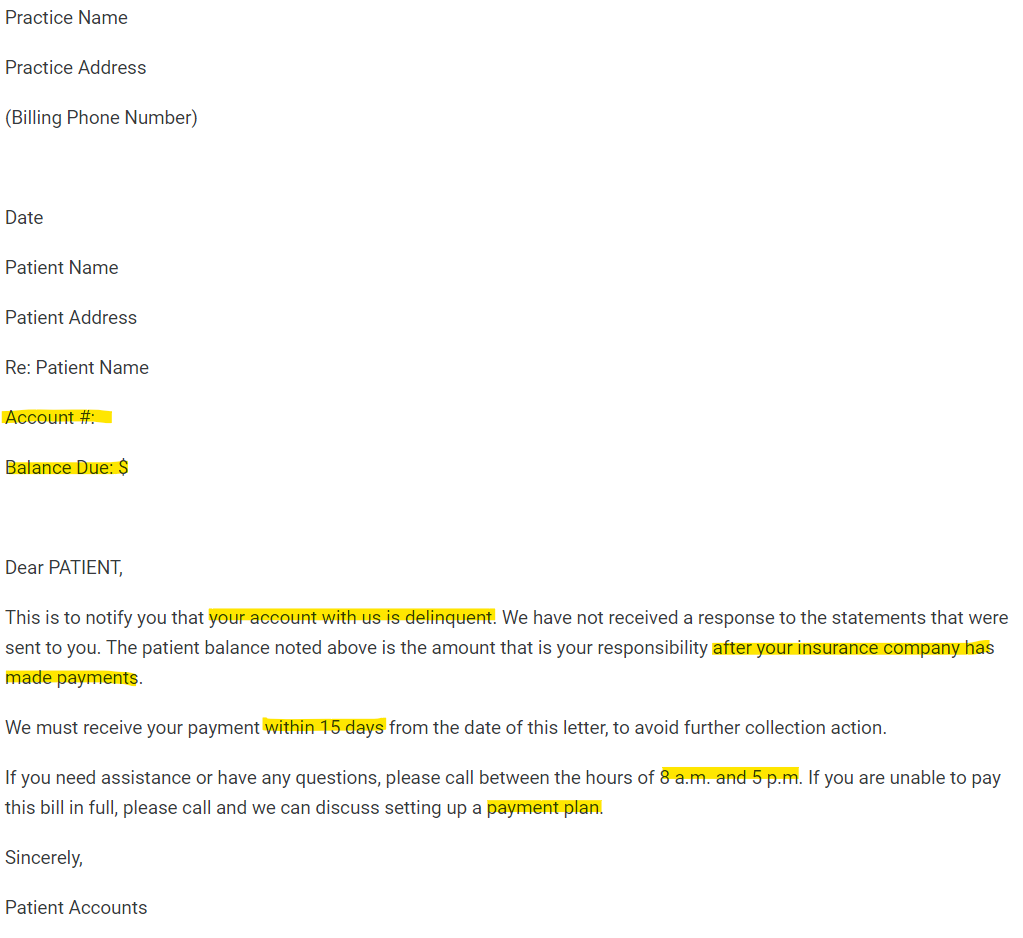How to Write a Medical Collection Letter for a Patient (Examples Included)
Here’s how you can write an effective collection letter that comes off professionally and decreases your outstanding debt.

The cost of healthcare is rising faster than American wages according to The Kaiser Family Foundation.
The modern-day patient is responsible for 30% of healthcare services. That places them within the top 3 largest payer groups, just behind Medicare and Medicaid.

Both of those statistics highlight where patient responsibility stands today. It’s not an easy scenario for many patients. Yet, as the healthcare provider, you have no choice but to follow the trend. It would be nice if you could wave a magic wand and change your client’s financial responsibilities, but you’re not a miracle worker in that sense.
The reality is that the most successful organizations, hospitals, and practices have a cohesive and detailed medical billing process in place.
In order to operate, you need a steady stream of revenue. At the end of the day, you’re a business. Yes, if you’re a doctor, the sole reason why you spent all of those years as a med student was so that you could enhance the medical field and treat patients.
You can’t continue to do so without some form of income.
Thus, you’re forced to establish your own medical billing process for your practice. Although there are many different steps, one of the most overlooked portions of this process involves creating and sending collection letters.
According to The American Collection Association, 63% of all medical debt isn’t ever collected.

If you’re a healthcare provider or office administrator, that statistic might make you feel uneasy. Meanwhile, it’s good news for collection agencies because it means that they’ll have a steady stream of clients for years to come.
Although you should work with a collections agency, you shouldn’t chalk up everything as bad debt. You may be able to close outstanding account balances before they’re sent to a third-party organization.
Here’s how you can write an effective collection letter that comes off professionally and decreases your outstanding debt.
Catch The Eye of Your Reader
Think about the last time you received a bill. Could you tell which organization it was from while you were wheeling through your stack of mail? Or, did it mistaken as junk mail because it didn’t stand out?
Direct mail marketers swear by a technique known as the 3:33 rule. In essence, it states that you need to make your envelope stand out from the stack in three seconds or fewer in order to avoid the garbage. Further, you have 30 seconds to engage the reader and then three minutes to prompt a response.

Although this rule pertains to promotional material, it’s still an effective strategy to keep in mind when writing a collection letter to your patients.
Before you’ve even started writing you need to plan out how everything is going to look.
Ask yourself evaluation questions like…
- Can the recipient easily identify who this letter came from before opening the envelope?
- Does the letter itself look like an official, professional document?
- Are there any personal touches that indicate that an actual person wrote and signed the letter?
You’ll need to keep all of these factors in mind prior to drafting your collection letters. Anything you send, no matter how large or small your organization is, should contain your logo and branding.
81% of consumers say that they need to be able to trust a brand in order to buy from them. This statistic is similar to the one I gave earlier in this section in that it isn’t directly related to patient collections. Nevertheless, it still hits the main concept.

In this case, consumers aren’t “buying” from you. Instead, they’ve already “bought” your organization’s services in receiving treatment. This type of transaction in the commercial space uses an invoice. In healthcare, the technical term for “invoice” is “statement”.
I could continue to break down the similarities between the transactions from the commercial space and healthcare space by putting words in quotation marks, but you get the point.
Patients and consumers aren’t going to feel comfortable purchasing something without trust.
To stay within the scope of this blog post, if you’re writing them a collection letter trust already exists. However, sending them something through the mail is much different than them choosing your organization to schedule an appointment.
You’re reaching out to them at their personal address and have to compete against an entire stack of other people and organizations trying to get their attention.
At this point, you’ve probably sent the patient multiple statements containing custom dunning messages giving them an update on the status of their account. It’s possible that those bills got lost in the mail because they weren’t eye-catching enough, either. But statement design is a different story.
Information You MUST Include
After you’ve designed the letter in an eye-catching way, it’s time to begin the drafting process.
Luckily for you, collection letters aren’t unique to just the medical space. I briefly mentioned earlier that there’s an entire industry devoted to trying to collect bad debts on behalf of other businesses.
Why not use that knowledge to your advantage?
When you’re writing a medical collection letter, conduct research online and find pre-existing templates to create a foundation.

The medical collection letter example above isn’t necessarily spectacular. In fact, it goes against my entire section earlier about being eye-catching. There’s an area at the top letterhead that’s a placeholder for the name and address of your practice, but that doesn’t cut it when trying to build trust.
However, it is a good example to refer to when trying to determine what information to include when you’re writing your own version.

The screenshot above is of the same example but I went through and highlighted all of the information you should include…
- Account number
- Balance due
- Account status
- Patient responsibility
- Due date
- Office hours
- Financial relief
All seven of those pieces of data help paint an obvious picture for the recipient of the collection letter. In essence, they help say, “Your payment is way overdue and you need to pay us soon or you’ll face some consequences. If you need help, we provide the ability to divvy up charges with a plan.” Yet, it’s much less forward and more professional.
Sending collection letters isn’t easy.
The best-case scenario is that the patient never received their statement in the first place because it went to the wrong address. Although that might mean you have a HIPAA violation on your hands, your patient might be able to close their overdue account quickly.

The more common scenario is that your client can’t afford to pay what they owe you. The reality is that 1 in 4 Americans skip medical care altogether because of the costs associated with it.
In other words, sending medical collection letters is an unfortunate reality that many healthcare organizations face. So, understanding what data you should always include help makes this process a little bit easier.
Catch The Eye of Your Reader
Think about the last time you received a bill. Could you tell which organization it was from while you were wheeling through your stack of mail? Or, did it mistaken as junk mail because it didn’t stand out?
Direct mail marketers swear by a technique known as the 3:33 rule. In essence, it states that you need to make your envelope stand out from the stack in three seconds or fewer in order to avoid the garbage. Further, you have 30 seconds to engage the reader and then three minutes to prompt a response.

Although this rule pertains to promotional material, it’s still an effective strategy to keep in mind when writing a collection letter to your patients.
Before you’ve even started writing you need to plan out how everything is going to look.
Ask yourself evaluation questions like…
- Can the recipient easily identify who this letter came from before opening the envelope?
- Does the letter itself look like an official, professional document?
- Are there any personal touches that indicate that an actual person wrote and signed the letter?
You’ll need to keep all of these factors in mind prior to drafting your collection letters. Anything you send, no matter how large or small your organization is, should contain your logo and branding.
81% of consumers say that they need to be able to trust a brand in order to buy from them. This statistic is similar to the one I gave earlier in this section in that it isn’t directly related to patient collections. Nevertheless, it still hits the main concept.

In this case, consumers aren’t “buying” from you. Instead, they’ve already “bought” your organization’s services in receiving treatment. This type of transaction in the commercial space uses an invoice. In healthcare, the technical term for “invoice” is “statement”.
I could continue to break down the similarities between the transactions from the commercial space and healthcare space by putting words in quotation marks, but you get the point.
Patients and consumers aren’t going to feel comfortable purchasing something without trust.
To stay within the scope of this blog post, if you’re writing them a collection letter trust already exists. However, sending them something through the mail is much different than them choosing your organization to schedule an appointment.
You’re reaching out to them at their personal address and have to compete against an entire stack of other people and organizations trying to get their attention.
At this point, you’ve probably sent the patient multiple statements containing custom dunning messages giving them an update on the status of their account. It’s possible that those bills got lost in the mail because they weren’t eye-catching enough, either. But statement design is a different story.
Information You MUST Include
After you’ve designed the letter in an eye-catching way, it’s time to begin the drafting process.
Luckily for you, collection letters aren’t unique to just the medical space. I briefly mentioned earlier that there’s an entire industry devoted to trying to collect bad debts on behalf of other businesses.
Why not use that knowledge to your advantage?
When you’re writing a medical collection letter, conduct research online and find pre-existing templates to create a foundation.

The medical collection letter example above isn’t necessarily spectacular. In fact, it goes against my entire section earlier about being eye-catching. There’s an area at the top letterhead that’s a placeholder for the name and address of your practice, but that doesn’t cut it when trying to build trust.
However, it is a good example to refer to when trying to determine what information to include when you’re writing your own version.

The screenshot above is of the same example but I went through and highlighted all of the information you should include…
- Account number
- Balance due
- Account status
- Patient responsibility
- Due date
- Office hours
- Financial relief
All seven of those pieces of data help paint an obvious picture for the recipient of the collection letter. In essence, they help say, “Your payment is way overdue and you need to pay us soon or you’ll face some consequences. If you need help, we provide the ability to divvy up charges with a plan.” Yet, it’s much less forward and more professional.
Sending collection letters isn’t easy.
The best-case scenario is that the patient never received their statement in the first place because it went to the wrong address. Although that might mean you have a HIPAA violation on your hands, your patient might be able to close their overdue account quickly.

The more common scenario is that your client can’t afford to pay what they owe you. The reality is that 1 in 4 Americans skip medical care altogether because of the costs associated with it.
In other words, sending medical collection letters is an unfortunate reality that many healthcare organizations face. So, understanding what data you should always include help makes this process a little bit easier.
Watch Your Tone
I hinted at this toward the end of the last section. The tone you use in a medical collection letter matters tremendously.
It’s a sensitive topic, especially when you consider statistics from Kaiser Family Foundation that determined sacrifices patients make for their medical bills like…
- 37% borrowed money from friends or family
- 34% increased their credit card debt
- 70% cut back spending on food, clothing, or other basic household items
- 41% took an extra job or worked more hours
- 59% used up most or all of their savings
You most likely don’t look forward to writing and sending collection letters to your overdue accounts. The statistics above probably don’t make you feel any better about writing them, either. Yet, if you want to keep your doors open you have to collect what’s owed by your patients.
One of the most important aspects to keep in mind when you’re writing is the tone of voice you’re using.
50% of emails and texts get misunderstood. Worse, 43% of people see email as the main cause of confusion and/or resentment in the workplace.
The point I’m trying to make is that people have a tendency to misinterpret the tone of voice through text often and a medical collection letter is no different.

The example letter above uses a more light-hearted approach. The relationship you have with your clients is special, especially when you consider the trends in value-based care. Thus, using a tone that focuses on a collaborative approach toward settling an outstanding balance comes off as personable.

The second example within this section still uses a nicer tone but takes a keen focus on time. What’s most interesting in this instance is the two body paragraphs.
The first of the two talks about previous attempts that the practice made to receive the patient’s payment in a sincere way. It doesn’t come off as patronizing or pleading.
The second body paragraph is in an understanding and empathetic tone. It says, “Hey, we know this payment might be a lot right now. As a result, we’re willing to work with you the best we can to close this debt.”
These two examples are effective because of the friendly tone they take on. If you’re sending a collection letter to a patient, they’ve received their original statement multiple times and you’re making your last attempt for payment. But that doesn’t mean you have to come off annoyed or intimidating.
Pick a Channel
As we know, people have different preferences for their healthcare experience based on their generation.
As a result, the channel(s) you use when sending your medical collection letters matter.
Maybe you’ve only sent the delinquent younger patient their statements via mail. In that case, it probably would’ve been helpful to know that Millennials spend around 6.4 hours per day checking their email. In other words, you might’ve had more success with this account if you knew that statistic.

Even though you’re not a collection agency, it’s helpful to understand how you’re allowed to contact your outstanding accounts by law. According to the FTC, collection agencies can use phone calls, physical mail, emails, and/or text messages in their efforts.
That’s helpful information for you to know as well. You’re allowed to contact your patients in a similar manner, as long as you ensure that you’re also following HIPAA guidelines.
Thus, send your letters to patients in formats that they’re more likely to read.
Conclusion
Trying to collect from patients isn’t an easy process. In a perfect world, they pay any outstanding balance they might have with you the moment they receive their first statement.
Yet, as you know, it’s much more difficult than that due to a variety of reasons including…
- Increasing healthcare costs
- Patient responsibility trends
- Value-based care trends
- Frequency of sending
- Patient demographics
That list could go on and on.
The reality is that you need to collect from your patients in order to keep your doors open. Many medical organizations and practices don’t consider themselves “businesses”. They didn’t start with the sole purpose of making money, they wanted to treat those who are sick or injured.
Nevertheless, sending collection letters is a necessary part of the job and you now know how to draft up an effective one that’s reflective of your practice and empathetic in nature.
Emphasize your product's unique features or benefits to differentiate it from competitors
In nec dictum adipiscing pharetra enim etiam scelerisque dolor purus ipsum egestas cursus vulputate arcu egestas ut eu sed mollis consectetur mattis pharetra curabitur et maecenas in mattis fames consectetur ipsum quis risus mauris aliquam ornare nisl purus at ipsum nulla accumsan consectetur vestibulum suspendisse aliquam condimentum scelerisque lacinia pellentesque vestibulum condimentum turpis ligula pharetra dictum sapien facilisis sapien at sagittis et cursus congue.
- Pharetra curabitur et maecenas in mattis fames consectetur ipsum quis risus.
- Justo urna nisi auctor consequat consectetur dolor lectus blandit.
- Eget egestas volutpat lacinia vestibulum vitae mattis hendrerit.
- Ornare elit odio tellus orci bibendum dictum id sem congue enim amet diam.
Incorporate statistics or specific numbers to highlight the effectiveness or popularity of your offering
Convallis pellentesque ullamcorper sapien sed tristique fermentum proin amet quam tincidunt feugiat vitae neque quisque odio ut pellentesque ac mauris eget lectus. Pretium arcu turpis lacus sapien sit at eu sapien duis magna nunc nibh nam non ut nibh ultrices ultrices elementum egestas enim nisl sed cursus pellentesque sit dignissim enim euismod sit et convallis sed pelis viverra quam at nisl sit pharetra enim nisl nec vestibulum posuere in volutpat sed blandit neque risus.

Use time-sensitive language to encourage immediate action, such as "Limited Time Offer
Feugiat vitae neque quisque odio ut pellentesque ac mauris eget lectus. Pretium arcu turpis lacus sapien sit at eu sapien duis magna nunc nibh nam non ut nibh ultrices ultrices elementum egestas enim nisl sed cursus pellentesque sit dignissim enim euismod sit et convallis sed pelis viverra quam at nisl sit pharetra enim nisl nec vestibulum posuere in volutpat sed blandit neque risus.
- Pharetra curabitur et maecenas in mattis fames consectetur ipsum quis risus.
- Justo urna nisi auctor consequat consectetur dolor lectus blandit.
- Eget egestas volutpat lacinia vestibulum vitae mattis hendrerit.
- Ornare elit odio tellus orci bibendum dictum id sem congue enim amet diam.
Address customer pain points directly by showing how your product solves their problems
Feugiat vitae neque quisque odio ut pellentesque ac mauris eget lectus. Pretium arcu turpis lacus sapien sit at eu sapien duis magna nunc nibh nam non ut nibh ultrices ultrices elementum egestas enim nisl sed cursus pellentesque sit dignissim enim euismod sit et convallis sed pelis viverra quam at nisl sit pharetra enim nisl nec vestibulum posuere in volutpat sed blandit neque risus.
Vel etiam vel amet aenean eget in habitasse nunc duis tellus sem turpis risus aliquam ac volutpat tellus eu faucibus ullamcorper.
Tailor titles to your ideal customer segment using phrases like "Designed for Busy Professionals
Sed pretium id nibh id sit felis vitae volutpat volutpat adipiscing at sodales neque lectus mi phasellus commodo at elit suspendisse ornare faucibus lectus purus viverra in nec aliquet commodo et sed sed nisi tempor mi pellentesque arcu viverra pretium duis enim vulputate dignissim etiam ultrices vitae neque urna proin nibh diam turpis augue lacus.




